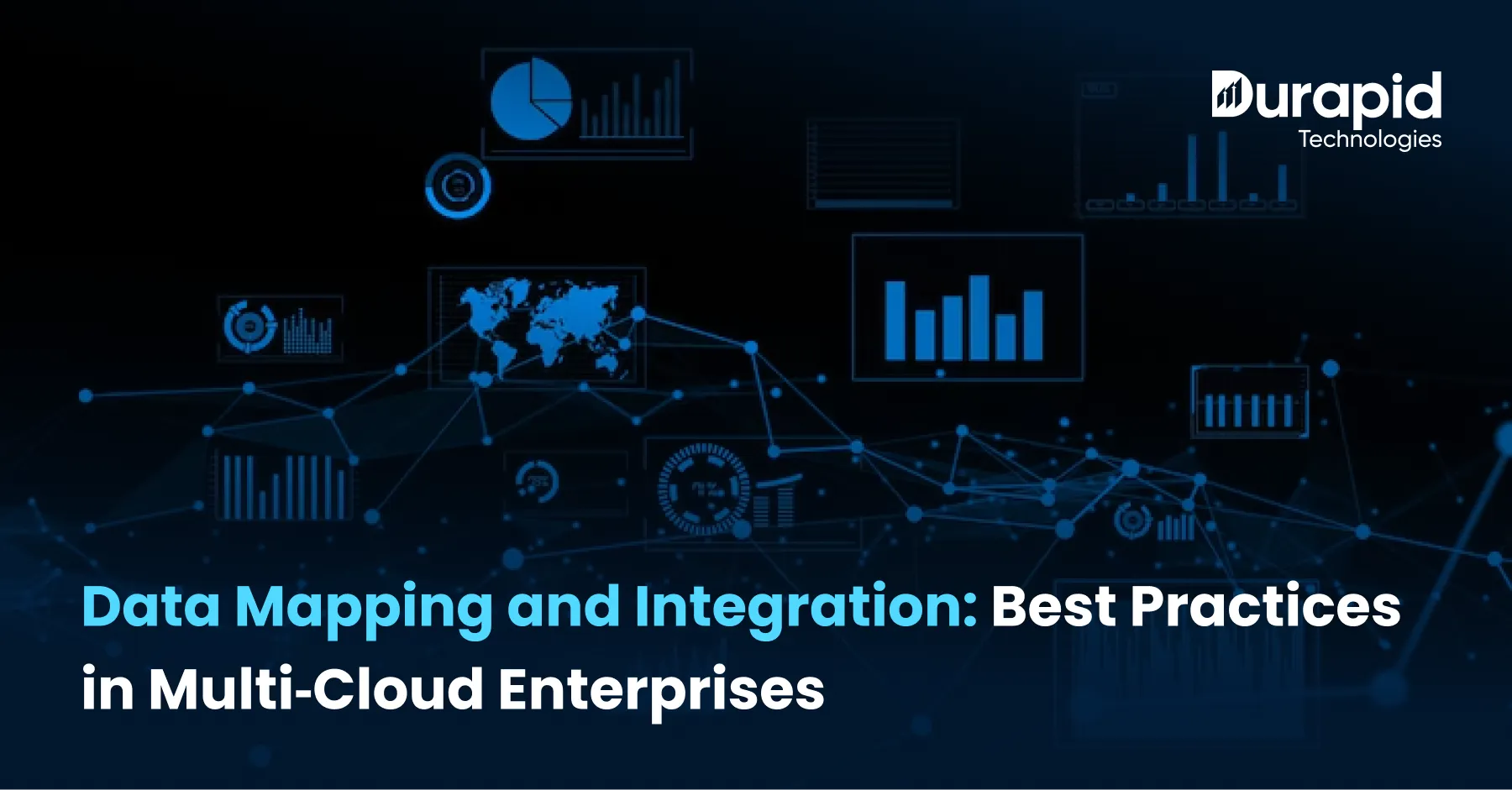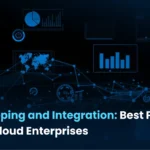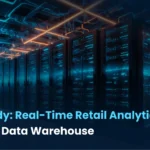Data Mapping and Integration: Best Practices in Multi‑Cloud Enterprises

What do most modern enterprises have in common?
A scattered mess of data. Sales numbers on AWS. Customer feedback on GCP. Supply chain stats buried in an old Oracle database. If this sounds familiar, you’re not alone. And you’re not stuck.
Enterprise data integration is what turns this chaos into clarity. And in a multi-cloud world, where you’re juggling AWS, Azure, GCP, and even on-prem systems, data mapping and integration aren’t just “nice-to-haves”, they’re the backbone of operational sanity.
The catch?
It’s never just about “moving” data, it’s about connecting it meaningfully, respecting governance, maintaining consistency, and delivering real-time value without breaking SLAs or budgets.
This blog breaks it all down, data mapping best practices, architectural considerations, real-life multi-cloud data integration use cases for enterprises, and a step-by-step guide to data mapping in a multi-cloud environment.
Let’s get your architecture out of survival mode and into intelligent orchestration.
Why Multi-Cloud Data Integration Matters
Here’s the reality:
Most enterprises today use at least two cloud providers—intentionally or by accident (yes, looking at you, “that one product team that decided to build on Azure without telling IT”).
Multi-cloud data environments aren’t just popular, they’re necessary for resilience, cost optimization, and flexibility.
But with that power comes fragmentation. And that’s where enterprise data integration strategy steps in.
A solid strategy means:
- Smart data orchestration, not just copying and pasting datasets around
- Compliance with data localization and privacy laws (think GDPR, HIPAA)
- Clear cost control (because 10X data movement costs? Ouch.)
- Near-zero tolerance for downtime
Example:
Sony Interactive Entertainment (yes, PlayStation) uses a multi-cloud data approach to manage its global services. Their teams orchestrate data pipelines across regions, using GCP for AI models, AWS for global CDNs, and local clouds for compliance-heavy zones. The result? Global performance without breaking privacy rules (source).
Done right, cloud-based data integration reduces vendor lock-in and gives your team the freedom to optimize workloads where they work best.
Core Technical Components & Data Mapping Best Practices
Let’s move from theory to actual technical moves. Because integration isn’t magic—it’s math, architecture, and habits.

1. Create a Unified Data ArchitectureStep one in data mapping best practices is getting everyone on the same page, literally.
- Inventory all data sources, PostgreSQL DBs, cloud storage buckets, legacy SAP modules, REST APIs, SaaS apps.
- Use schema mapping tools to standardize data fields even if one system calls it “user_id” and the other uses “UID.”
- Implement transformation logic according to global standards like ISO 8000, so your master data doesn’t turn into a Frankenstein monster of mismatched formats.
- Store all of this in a metadata repository for easy lineage tracking, documentation, and automated governance triggers.
Real Example:
At Airbnb, data from customer bookings, host chats, and payment systems is centralized into a single Lakehouse using Apache Iceberg and dbt. The key? A unified schema layer that allows engineers and analysts to “speak the same language,” regardless of the source platform.
This approach ensures smooth data integration for hybrid cloud setups too where part of your infra is still on-prem.
2. Choose Integration Style: ETL vs. ELT vs. Hybrid
Integration isn’t one-size-fits-all. Your architecture needs to pick a strategy that balances performance, cost, and complexity.
ETL (Extract → Transform → Load)
- Ideal when data governance in multi-cloud needs strict control before anything touches your data warehouse
- Suited for regulated industries (finance, healthcare)
- Typically slower but tightly controlled
ELT (Extract → Load → Transform)
- Works best in cloud-native architectures
- Load raw data directly into your warehouse (like BigQuery or Snowflake)
- Use cloud-native power to transform at scale
Hybrid (Streaming + Batch)
- Combine both approaches
- Stream real-time data (Kafka, Pub/Sub) while running nightly batch jobs for historical loads
Example:
Netflix uses a hybrid approach. Logs and viewing events stream in real time using Kafka, while static metadata updates run in nightly Spark jobs. This lets them respond instantly and maintain deep historical context.
3. Metadata‑Driven Data Orchestration
When your data lives across three clouds, five vendors, and two continents, you don’t “wing it.” You orchestrate it.
Use tools like:
- Apache NiFi or Airflow to manage flow dependencies
- AWS Glue, Azure Data Factory, or GCP Cloud Composer for cloud-native orchestration
- Data catalogs (like Collibra or Atlan) to document schemas, freshness, and access roles
This metadata-driven architecture isn’t just neat, it’s essential for automation and self-healing pipelines.
Example:
GE Aviation uses metadata-first orchestration to manage terabytes of engine telemetry data. Their platform auto-adjusts transformations based on schema changes so if a field changes upstream, alerts are raised before pipelines break. That’s data governance in multi-cloud in action.
Data Governance in Multi-Cloud: Building Trust Across the Clouds
Let’s get this straight, data governance in multi-cloud is not just about control. It’s about building trust in a world where your data lives in ten different clouds and is touched by ten different teams.
Here’s what real enterprise-grade governance looks like:
- Ownership is not vague. It’s defined down to the dataset. You know exactly who owns what, who approves schema changes, and who gets a Slack ping when data fails to load at 3 AM.
- Stewardship is active. Data stewards are not a title on Confluence, they’re the ones who keep lineage documentation alive and guide the team through schema migrations.
- Access control isn’t a “one-role-fits-all” thing. It’s granular. You use Role-Based Access Control (RBAC), encryption at rest and in transit, and automated access revocation policies when someone leaves the org.
Technical Specifications: Because Pretty Dashboards Don’t Move Petabytes
Let’s skip the fluff.
If you’re serious about multi cloud data, your stack should not only scale, it should speak the language of performance, security, and recovery. Here’s your cheat sheet for technical architecture that actually works:
| Component | Recommendation & Specs |
| Connectivity | VPC/VNet Peering, or VPN tunnels; 10 Gbps egress recommended. All connections TLS secured. |
| Schema Format | Use portable formats like Parquet or Avro. Centralize via schema registries. |
| Transform Engines | Choose modular compute: Apache Spark, dbt Cloud, or Azure Data Factory. |
| Orchestration | Go with DAG-based workflows. Think Apache Airflow, AWS Step Functions, or GCP Composer. |
| Monitoring | Use Grafana, OpenTelemetry or cloud-native dashboards. Track metadata + SLA alerts. |
Tech Stack Spotlight
For a media analytics enterprise that juggles petabytes daily across S3, BigQuery, and Snowflake, we deployed Airflow on Kubernetes, used Avro for schema evolution, and containerized their dbt pipelines for elasticity.
They called it magic. We called it intentional architecture.
Step-by-Step Guide to Data Mapping in a Multi-Cloud Environment

Now for the real stuff. The operational grind. Here’s the step-by-step guide to data mapping in a multi-cloud environment, with practical insights and sprinkled brilliance.
1. Inventory Your Sources
First, know what you’re working with. Map every database, every API, every CSV living in someone’s inbox. One client had 132 different sources across their marketing and ops teams and 17 of them were undocumented!
Tip: Use auto-discovery tools like Collibra or OpenMetadata to detect rogue data.
2. Define a Unified Model
You need a central schema, a north star that aligns customer_id from CRM, eComm, and support systems. This is your data Rosetta Stone.
3. Auto-Map Fields Across Clouds
Using schema mapping tools (think Talend, Informatica, or even Airbyte), standardize fields that look different but mean the same. Map user_id to customer_id, cast timestamp as UTC, align your data types.
This is where data orchestration starts shining. If something changes upstream, your system auto-adjusts downstream.
4. Transform and Enrich
Apply data mapping best practices here. Cleanse nulls. Standardize dates. Convert currencies. Enrich using third-party APIs (e.g., geolocation or customer segmentation).
One insurance client enriched policyholder data using external climate data (yes, weather forecasts!). Result? Their predictive risk model for flood-prone areas improved by 43%.
5. Load and Validate
This part is less interesting, but mission-critical. Before pushing to your warehouse/lake, validate every batch:
- Row counts
- Field-level null checks
- Hash validation (for change detection)
Use Great Expectations or Soda for data tests. Integrate them into your cloud based data integration pipeline.
6. Monitor and Iterate
You’re not done. Now comes the watchtower.
Set SLA-based alerts for every DAG. Use drift detection. Your Airflow should tell you when the schema changes. Your BI team should never be the first to spot missing data.
Use logging tools like OpenLineage, integrate with Slack/Teams, and track everything.
Multi‑Cloud Data Integration Use Cases for Enterprises
360° Customer View
Top‑tier banks and fintechs leverage multi cloud data to unify customer interactions. For example, one leading financial institution stitched together Salesforce on AWS, Google Analytics on GCP, and on‑premise support logs via Azure Data Factory, achieving a synchronized 360° customer view in under 30 minutes. This fusion of customer, web, and support data drove real-time personalization, skyrocketing conversion rates, real enterprise data integration in action.
Global Analytics Platform
A worldwide retail conglomerate crafted an analytics powerhouse using cloud‑based data integration:
- Data lake in AWS for lifecycle management
- BI dashboards on GCP
- ML training on Azure
Using Apache Airflow and Parquet schema standards, they slashed ETL execution costs by 40% and delivered near real-time dashboards. This shines as a flagship enterprise data integration strategy, harmonizing systems across clouds.
IoT & Edge‑to‑Cloud Orchestration
Multi‑cloud data integration isn’t just theoretical, it’s critical to operations:
- GE Digital ingested IIoT sensor feeds at the edge, processed on Kubernetes, and pushed insights to cloud ML workloads. This improved throughput and boosted platform uptime by 25% .
- World Kinect deployed 750 IoT‑enabled vehicles, streaming telemetry via 5G into unified cloud pipelines, transforming fleet emissions monitoring with transparency and sustainability gains .
These real-world integrations highlight data mapping best practices and data governance in multi‑cloud contexts, where proper schema alignment and orchestration are vital.
Cloud‑Based Data Integration Tools & Platforms
Embrace tools designed for multi‑cloud orchestration, portable schemas, and robust governance:
- Talend Data Fabric offers drag-and-drop connectors across AWS, Azure, GCP, and Snowflake. Its Pipeline Designer lets teams build on-prem or cloud ETL streams in one pane.
- Informatica Cloud and Matillion deliver scalable ELT pipelines that adapt to changing cloud needs.
- Airbyte provides cloud based data integration with low-code templates supporting data integration for hybrid cloud environments effortlessly.
- Frameworks like Apache Camel plug into microservices architectures, enabling secure, protocol-compliant data orchestration at scale.
Choosing low‑code/no‑code offerings accelerates delivery, enforces enterprise data integration strategy, and embeds data governance in multi‑cloud workflows.
Best Practices Checklist

- Scalable Architecture: Harness Kubernetes or serverless autoscaling for elasticity across clouds.
- Simplified Integration: Use metadata-driven templates and prebuilt connectors as highlighted by Talend and Deloitte to fast-track implementation.
- Robust Monitoring: Build centralized dashboards with SLA-based alerts and anomaly detection.
- Governance-First: Apply encryption (at rest/in transit), schema version control, RBAC, and audit logging across every environment.
- Continuous Improvement: Run regular data retrospectives, support data integration for hybrid cloud, and integrate feedback from analytics, finance, and compliance teams.
Conclusion
Here’s the deal, enterprise data integration in a multi-cloud world isn’t sparkly.
It’s smart strategy, solid governance, and the right tools working together. Nail your data mapping best practices and lean on good data orchestration, and suddenly, your data flows smoothly, decisions get sharper, and teams move faster.
Look at Ciox, GE, World Kinect, and Talend, they’re all winning because they’ve got a real enterprise data integration strategy that just works.
Want to level up? Check out Durapid’s guide, perfect for anyone ready to build cloud data systems that actually deliver. Start your smarter multi-cloud journey now.





